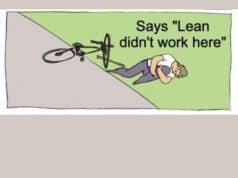Mark's note: Ah, another NFL playoff weekend and time for another football post to follow up my apparent jinxing of the Eagles' head coach Chip Kelly last week. Today's guest post from Chad Walters is an intersection between sports, medicine, and Lean.
Last weekend during the NFL playoffs, two players – David Bakhtiari of the Green Bay Packers and Keenan Lewis of the New Orleans Saints – violated the NFL's concussion protocol by not immediately leaving the field or sideline after being diagnosed with concussions. In fact, Bakhtiari re-entered his game for a play after being diagnosed with a concussion.
“NFL: Two violated concussion rules” (ESPN)
The NFL's policy regarding diagnosed concussions – the “Madden Rule” – requires that players diagnosed with concussions on the sidelines or field of play must be taken away from the field to the locker room or somewhere else that's quiet as quickly as possible.
However, the medical staffs and coaches of the Packers and Saints failed to accomplish this, even taking on serious risk of exacerbating the problem by allowing a concussed player to return to action. If it's a requirement, why wasn't it followed?
From a letter sent to all NFL team doctors and trainers from Dr. Hunt Batjer and Dr. Richard Ellenbogen, the NFL's head, neck, and spine committee chairmen:
“If a player refuses to follow your advice and leave the sidelines after being diagnosed with a concussion, we recommend that the head athletic trainer seek assistance from the player's position coach (or another member of the coaching staff) or from another team official to remove the player from the sidelines as soon as possible.”
However, the doctors also found no fault in the medical staffs in their handling of the situation, according to the same letter and no fines will be levied for violation.
When the policy is referred to as a rule, but it's based on following “advice” and “recommendations” in order to be enforced, it ceases to be a rule and more of a guideline.
The ideal outcome of the concussion testing process should be if a player is diagnosed with a concussion he is relocated to the locker room, but the success of that current process is based on rules adherence instead of something with teeth that can't be violated – sounds like an opportunity for poka yoke (or error proofing)!
The hierarchy for reducing the opportunity for error is:
- Error-proofing/poka yoke – the opportunity for error has been eradicated
- Error-reducing – the opportunity for error has been minimized
- Error-contain – quarantine or separating the opportunity for error so it is under better control
- Checklists/inspection – reactive verification that no errors are passed along to next process steps
- Rules/policy – last resort to minimizing the effects of errors where the other reduction levels are impossible or unavailable
The higher up you can go in that hierarchy, the better off your process should be. The process is also as strong as its weakest link, and even though the concussion protocol uses a checklist for testing players, a rules-based enforcement that is easily violated means that the process is weak as well.
What the NFL should look to implement is higher-level poka yoke measures to better ensure that players leave the field in a timely manner. Here are some examples of ideas.
Much like the teams use an independent neurological observer to apply the concussion assessments on the sidelines (not affiliated with the teams, so as to reduce team bias and influence) the NFL teams could also use independent escorts who make sure players leave the field instead of relying on busy position coaches who are too focused on the game to “advise” players to leave.
The teams and players in this incident were not fined for violating the protocol – why not? While I am not an advocate of negative punishments for bad outcomes (nor should any continuous improvement practitioner be) I believe there should be immediate team consequences for taking risks with players' health that go beyond simple fines. (Have you seen the figures on how much the NFL rakes in? A fine is not even a drop in the bucket.)
What if those independent operators (the neurological observer and player escorts) indicate to game officials that a player is no longer eligible to return and the game is stopped until the player leaves (or begins to leave) the sideline? And if he does not begin to leave in a timely fashion his team receives either a yardage penalty or loss of a timeout in order to make sure he leave the field? An actual impact on the game at hand will definitely encourage managers to put priority on taking care of concussion-diagnosed players, wouldn't it?
 Chad Walters is a Lean consultant and owner of Lean Blitz Consulting in Augusta, Georgia, a firm focused on continuous improvement for small businesses and sports organizations. He has run projects for the Atlanta Braves, the Salvation Army, Automatic Data Processing (ADP), Eaton Corporation, The Dannon Company, and the South Bend Silver Hawks among other companies. He has been practicing Lean and continuous improvement for over eight years, is a Six Sigma Black Belt certified by the American Society for Quality, and received his MBA from Indiana University's Kelley School of Business, where he was a member of the Kelley MBA Sports & Entertainment Academy. Check out his blog…
Chad Walters is a Lean consultant and owner of Lean Blitz Consulting in Augusta, Georgia, a firm focused on continuous improvement for small businesses and sports organizations. He has run projects for the Atlanta Braves, the Salvation Army, Automatic Data Processing (ADP), Eaton Corporation, The Dannon Company, and the South Bend Silver Hawks among other companies. He has been practicing Lean and continuous improvement for over eight years, is a Six Sigma Black Belt certified by the American Society for Quality, and received his MBA from Indiana University's Kelley School of Business, where he was a member of the Kelley MBA Sports & Entertainment Academy. Check out his blog…
Please scroll down (or click) to post a comment. Connect with me on LinkedIn.
Let’s work together to build a culture of continuous improvement and psychological safety. If you're a leader looking to create lasting change—not just projects—I help organizations:
- Engage people at all levels in sustainable improvement
- Shift from fear of mistakes to learning from them
- Apply Lean thinking in practical, people-centered ways
Interested in coaching or a keynote talk? Let’s start a conversation.










Yes, a yardage penalty would be good. I’ve seen instances where they take the player’s helmet away from him, which would be fairly error proof. I once saw a player, relieved of his helmet and obviously having had his bell rung pretty good, looking all over the side lines for his helmet, as if he couldn’t remember where he had left his car keys.
If we ask “why aren’t the recommendations being followed?,” it seems that:
1) “Recommended” is far weaker than “required.” It’s harder to discipline somebody for not following a recommendation (as there’s an implication of judgment being allowed). I think of pre-op surgical timeouts… they should be required (unless there’s very extenuating circumstances) rather than being “recommended.”
2) Follow the money. The players AND the team have aligned incentives to want to win playoff games. It takes an outside and independent regulatory body, perhaps, to enforce rules that go against the financial interests of those involved (including the league). Sometimes doing the right thing has to come before money.
Chad – Percy Harvin was taken out of the game today because of a concussion (I tuned in after the fact). Did you see what protocol they followed? Did the announcers talk about it other than saying he was out?
I did not watch yesterday’s Seattle game so I missed the plays where Harvin came out, the protocols used, as well as the announcers’ analyses. I don’t even know what concussion protocols the neurological experts use on the sidelines.
However, this Forbes article (weird sports source, I know) suggests that the protocols weren’t fully followed after Harvin’s first “injury” because full completion takes more time than what apparently occurred. And obviously it wasn’t long before Harvin came out after another head shot.
Fortune Link
I think one of the hardest things for the league to appreciate is the shift in being overprotective over injuries that cannot be easily seen by the naked eye. Breaks, tweaks, pulls, cuts, they can all be seen after a play is over and pretty easily diagnosed. However, internal injuries and vague understanding of brain injuries means it’s hard to prepare, hard to estimate time needed for return, and hard to assess long term damage by toughing it out.
I’m not a doctor, obviously, but it seems the NFL concussion tests are somewhat subjective. It’s not like a blood test that returns a number.
Since being able to stay in the game (especially a playoff game) has HUGE financial implications for the players, there’s incentive for them to cheat the system. Cheating or gaming the system is pretty common human behavior, it’s not just an athlete thing.
This article says NFL players have admitted to cheating by intentionally doing badly on the “Baseline” test that’s taken.
Here is the test.
I see where a player could intentionally do badly at word recall, etc. do that their post-head-injury test doesn’t look as bad in comparison.
How does a doctor accuse a player of intentionally doing badly on the baseline test? You’re basically accusing them of being dumb, which is hard to do.
News article:
NFL Explains Why Players Not Fined For Violating Concussion Protocol
“Considering all the ways an NFL player can incur a fine, it did not look good when the league announced two players violated concussion protocol during wild-card games — but would not be fined.”
The league seems more concerned about a player wearing an unapproved logo than their safety.
“Essentially, Aiello said the league could not fine the players because there was no precedent for it.”
The NFL can’t get out of its own way.
Isn’t “precedent” another way of saying “that’s the way we’ve always done it”?
Yup. They aren’t the Supreme Court. They are a business that can make decisions.
Wait, they are actually a “non-profit,” which is a travesty of the tax code.
[…] do to prevent reinjury and extra medical intervention. I shared (in early 2014) a guest post about two NFL players violating concussion protocol without penalty and another post (in 2013) about a lesson taught to me by a […]